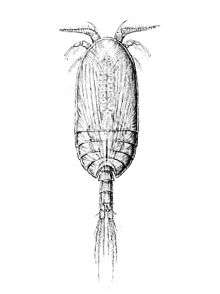Platycopiidae
Platycopiidae is a family of copepods. Until the description of Nanocopia in 1988, it contained the single genus Platycopia.[1] It now contains four genera, three of which are monotypic; the exception is Platycopia, with 8 species.
| Platycopiidae | |
|---|---|
 | |
| Platycopia perplexa | |
| Scientific classification | |
| Kingdom: | Animalia |
| Phylum: | Arthropoda |
| Subphylum: | Crustacea |
| Class: | Hexanauplia |
| Subclass: | Copepoda |
| Infraclass: | Progymnoplea Lang, 1948 |
| Order: | Platycopioida Fosshagen, 1985 |
| Family: | Platycopiidae G. O. Sars, 1911 |
| Genera | |
| |
Systematics
The family Platycopiidae was erected by Georg Ossian Sars when he described the new species P. perplexa, and included it in the order Calanoida.[2] In 1948, Karl Georg Herman Lang erected a new suborder, Progymnoplea, for the family, and in 1985, Audun Fosshagen & Thomas Iliffe created the order Platycopioida to contain the Platycopiidae, initially placed alongside Calanoida in the superorder Gymnoplea.[2] Most recently, Huys & Boxshall inferred that Platycopiidae was the earliest branching copepod lineage, making it the sister taxon to all other copepods; they therefore raised Progymnoplea to the rank of infraclass, to accommodate Platycopioida alone, with all other copepods being placed in the Neocopepoda.[2]
Members of the Platycopiidae have a primitive form, thought to be similar to the most recent common ancestor of all copepods. Few synapormorphies have been found to unite the family, but they include the presence of a second dorsal seta (hair) on particular segments of the legs.[3] They share with calanoid copepods the possession of Von Vaupel Klein's organ, a sensory organ near the base of the first swimming leg.[3]
Members
Antrisocopia prehensilis Fosshagen, 1985 is a critically endangered species from a limestone anchialine cave in Bermuda, known from only five mature specimens.[4]
Nanocopia minuta Fosshagen, 1988 is a critically endangered species from the same anchialine cave as Antrisocopia, and is known from only two specimens.[5]
Sarsicopia polaris Martínez Arbizu, 1997 was collected in 1993 from a depth of 534 metres (1,752 ft) in the Barents Sea.[2]
Platycopia comprises eight species, distributed in the North Sea, the eastern seaboard of North America, the Bahamas, Mauritania and Japan.[2] The first species to be described was P. perplexa, named by Georg Ossian Sars in 1911.[2]
References
- Fosshagen, Audun; Iliffe, Thomas M. (1988). Boxshall, G. A.; Schminke, H. K. (eds.). "Biology of Copepods" (PDF). Hydrobiologia. 167/168: 357–361. doi:10.1007/bf00026325.
|chapter=ignored (help) - Arbizu, Pedro Martínez (1997). "Sarsicopia polaris gen. et sp.n., the first Platycopioida (Copepoda: Crustacea) from the Arctic Ocean, and its phylogenetic significance". Hydrobiologia. 350 (1–3): 35–47. doi:10.1023/A:1003020829836.
- Ferrari, Frank D.; Dahms, Hans-Uwe (2007). "Post-embryonic development of the Copepoda" (PDF). Crustaceana Monographs. 8: 1–226. ISBN 90-04-15713-1.
- T. M. Iliffe (1996). "Antrisocopia prehensilis". IUCN Red List of Threatened Species. 1996: e.T1784A7539000. doi:10.2305/IUCN.UK.1996.RLTS.T1784A7539000.en.
- T. M. Iliffe (1996). "Nanocopia minuta". IUCN Red List of Threatened Species. 1996: e.T14331A4433047. doi:10.2305/IUCN.UK.1996.RLTS.T14331A4433047.en.